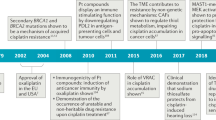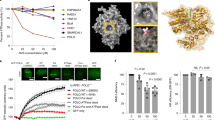Abstract
Genotoxic chemotherapy is the most common cancer treatment strategy. However, its untargeted generic DNA-damaging nature and associated systemic cytotoxicity greatly limit its therapeutic applications. Here, we used a haploid genetic screen in human cells to discover an absolute dependency of the clinically evaluated anticancer compound YM155 on solute carrier family member 35 F2 (SLC35F2), an uncharacterized member of the solute carrier protein family that is highly expressed in a variety of human cancers. YM155 generated DNA damage through intercalation, which was contingent on the expression of SLC35F2 and its drug-importing activity. SLC35F2 expression and YM155 sensitivity correlated across a panel of cancer cell lines, and targeted genome editing verified SLC35F2 as the main determinant of YM155-mediated DNA damage toxicity in vitro and in vivo. These findings suggest a new route to targeted DNA damage by exploiting tumor and patient-specific import of YM155.
This is a preview of subscription content, access via your institution
Access options
Subscribe to this journal
Receive 12 print issues and online access
$259.00 per year
only $21.58 per issue
Buy this article
- Purchase on Springer Link
- Instant access to full article PDF
Prices may be subject to local taxes which are calculated during checkout




Similar content being viewed by others
Accession codes
References
Younes, A. et al. Brentuximab vedotin (SGN-35) for relapsed CD30-positive lymphomas. N. Engl. J. Med. 363, 1812–1821 (2010).
Verma, S. et al. Trastuzumab emtansine for HER2-positive advanced breast cancer. N. Engl. J. Med. 367, 1783–1791 (2012).
Birsoy, K. et al. MCT1-mediated transport of a toxic molecule is an effective strategy for targeting glycolytic tumors. Nat. Genet. 45, 104–108 (2013).
Reiling, J.H. et al. A haploid genetic screen identifies the major facilitator domain containing 2A (MFSD2A) transporter as a key mediator in the response to tunicamycin. Proc. Natl. Acad. Sci. USA 108, 11756–11765 (2011).
Lanthaler, K. et al. Genome-wide assessment of the carriers involved in the cellular uptake of drugs: a model system in yeast. BMC Biol. 9, 70 (2011).
Dobson, P.D. & Kell, D.B. Carrier-mediated cellular uptake of pharmaceutical drugs: an exception or the rule? Nat. Rev. Drug Discov. 7, 205–220 (2008).
Kell, D.B., Dobson, P.D. & Oliver, S.G. Pharmaceutical drug transport: the issues and the implications that it is essentially carrier-mediated only. Drug Discov. Today 16, 704–714 (2011).
Giacomini, K.M. et al. Membrane transporters in drug development. Nat. Rev. Drug Discov. 9, 215–236 (2010).
Tolcher, A.W. et al. Phase I and pharmacokinetic study of YM155, a small-molecule inhibitor of survivin. J. Clin. Oncol. 26, 5198–5203 (2008).
Giaccone, G. et al. Multicenter phase II trial of YM155, a small-molecule suppressor of survivin, in patients with advanced, refractory, non-small-cell lung cancer. J. Clin. Oncol. 27, 4481–4486 (2009).
Nakamura, N. et al. Interleukin enhancer-binding factor 3/NF110 is a target of YM155, a suppressant of survivin. Mol. Cell. Proteomics 11, M111.013243 (2012).
Carette, J.E. et al. Haploid genetic screens in human cells identify host factors used by pathogens. Science 326, 1231–1235 (2009).
Carette, J.E. et al. Global gene disruption in human cells to assign genes to phenotypes by deep sequencing. Nat. Biotechnol. 29, 542–546 (2011).
Subramanian, A. et al. Gene set enrichment analysis: a knowledge-based approach for interpreting genome-wide expression profiles. Proc. Natl. Acad. Sci. USA 102, 15545–15550 (2005).
Glaros, T.G. et al. The “survivin suppressants” NSC 80467 and YM155 induce a DNA damage response. Cancer Chemother. Pharmacol. 70, 207–212 (2012).
Sappal, D.S. et al. Biological characterization of MLN944: a potent DNA binding agent. Mol. Cancer Ther. 3, 47–58 (2004).
Cohen, S.N. & Yielding, K.L. Inhibition of DNA and RNA polymerase reactions by chloroquine. Proc. Natl. Acad. Sci. USA 54, 521–527 (1965).
Bakkenist, C.J. & Kastan, M.B. DNA damage activates ATM through intermolecular autophosphorylation and dimer dissociation. Nature 421, 499–506 (2003).
Ishida, N. & Kawakita, M. Molecular physiology and pathology of the nucleotide sugar transporter family (SLC35). Pflugers Arch. 447, 768–775 (2004).
Song, Z. Roles of the nucleotide sugar transporters (SLC35 family) in health and disease. Mol. Aspects Med. 34, 590–600 (2013).
Sarangi, A., Bupp, K. & Roth, M.J. Identification of a retroviral receptor used by an envelope protein derived by peptide library screening. Proc. Natl. Acad. Sci. USA 104, 11032–11037 (2007).
Barretina, J. et al. The Cancer Cell Line Encyclopedia enables predictive modelling of anticancer drug sensitivity. Nature 483, 603–607 (2012).
Cong, L. et al. Multiplex genome engineering using CRISPR/Cas systems. Science 339, 819–823 (2013).
Mali, P. et al. RNA-guided human genome engineering via Cas9. Science 339, 823–826 (2013).
Hartwell, L.H., Culotti, J., Pringle, J.R. & Reid, B.J. Genetic control of the cell division cycle in yeast. Science 183, 46–51 (1974).
Minematsu, T. et al. Carrier-mediated uptake of 1-(2-methoxyethyl)-2-methyl-4,9-dioxo-3-(pyrazin-2-ylmethyl)-4,9-dihydro-1H-naphtho[2,3-d]imidazolium bromide(YM155 monobromide), a novel small-molecule survivin suppressant, into human solid tumor and lymphoma cells. Drug Metab. Dispos. 37, 619–628 (2009).
Minematsu, T., Iwai, M., Umehara, K., Usui, T. & Kamimura, H. Characterization of human organic cation transporter 1 (OCT1/SLC22A1)- and OCT2 (SLC22A2)-mediated transport of 1-(2-methoxyethyl)-2-methyl-4,9-dioxo-3-(pyrazin-2-ylmethyl)-4,9-dihydro-1H-naphtho[2,3-d]imidazolium bromide (YM155 monobromide), a novel small molecule survivin suppressant. Drug Metab. Dispos. 38, 1–4 (2010).
Trapnell, C., Pachter, L. & Salzberg, S.L. TopHat: discovering splice junctions with RNA-Seq. Bioinformatics 25, 1105–1111 (2009).
Langmead, B., Trapnell, C., Pop, M. & Salzberg, S.L. Ultrafast and memory-efficient alignment of short DNA sequences to the human genome. Genome Biol. 10, R25 (2009).
Wang, L., Wang, S. & Li, W. RSeQC: quality control of RNA-seq experiments. Bioinformatics 28, 2184–2185 (2012).
Wang, L., Feng, Z., Wang, X., Wang, X. & Zhang, X. DEGseq: an R package for identifying differentially expressed genes from RNA-seq data. Bioinformatics 26, 136–138 (2010).
Wang, H. et al. One-step generation of mice carrying mutations in multiple genes by CRISPR/Cas-mediated genome engineering. Cell 153, 910–918 (2013).
Toledo, L.I., Murga, M., Gutierrez-Martinez, P., Soria, R. & Fernandez-Capetillo, O. ATR signaling can drive cells into senescence in the absence of DNA breaks. Genes Dev. 22, 297–302 (2008).
Gyori, B.M., Venkatachalam, G., Thiagarajan, P.S., Hsu, D. & Clement, M.V. OpenComet: an automated tool for comet assay image analysis. Redox Biol. 2, 457–465 (2014).
Acknowledgements
We thank all of the members of the Superti-Furga research laboratory and U. Rix (Moffitt Cancer Center) for skillful advice and discussions. The present work was, in part, financed by the Austrian Academy of Sciences (S.K., R.K.K., G.S.-F., D.C. and T.K.); the Gen-AU initiative of the Austrian Federal Ministry for Science, Research and Economy (G.E.W., PLACEBO); the European Commission (B.R., K.V.M.H. and M.G., grant agreement number 259348, ASSET); the European Research Council (R.K.K., grant agreement number 250179, i-FIVE); and the Swiss National Science Foundation (C.T., Fellowship). T.R.B. is funded by the Cancer Genomics Center (http://www.cancergenomics.nl/) and the Netherlands Organisation for Scientific Research–VIDI grant 91711316. Work in the O.F.-C. laboratory was supported by grants from the Spanish Ministry of Economy and Competitiveness (SAF2011-23753), the Association for International Cancer Research (12-0229), the Howard Hughes Medical Institute and the European Research Council (ERC-617840). C.M.-R. is funded by a PhD fellowship from La Caixa Foundation.
Author information
Authors and Affiliations
Contributions
G.E.W. designed and performed experiments, analyzed and interpreted the data, made the figures and wrote the manuscript. B.R. designed and performed experiments, interpreted the data and prepared figures. C.M.-R. performed the mouse xenograft experiments, high-content microscopy and the comet assay. V.A.B. helped perform the haploid genetic screen and conducted statistical analysis. C.T. performed the RNA sequencing experiment and helped to perform MRM measurements. R.K.K. analyzed RNA sequencing data and performed statistical analysis. K.V.M.H. helped to set up MRM measurements and gave experimental advice. M.G. assisted with immunoblot analysis. D.C. created the Circos plot and a graphical display of insertion sites. T.K. operated the next-generation sequencer (Illumina HiSeq 2000) and helped with next-generation sequencing data handling. R.K. gave experimental advice and supervised next-generation sequencing. S.K. gave experimental advice and designed experiments. O.F.-C. designed the mouse xenograft study and analyzed and interpreted data. T.R.B. codesigned the study and gave experimental advice. G.S.-F. codesigned and supervised the study and wrote the manuscript.
Corresponding author
Ethics declarations
Competing interests
T.R.B. and G.S.-F. are cofounders and shareholders of Haplogen GmbH, a company involved in haploid genetics.
Supplementary information
Supplementary Text and Figures
Supplementary Results and Supplementary Figures 1–11. (PDF 39594 kb)
Supplementary Table 1
The number of retroviral insertions in genes from YM155-resistant colonies compared to that in control colonies. (XLSX 70 kb)
Supplementary Table 2
Raw data showing transcriptional changes in KBM7WT versus KMB7GT1 cells with 1 μM YM155 treatment. (XLSX 3338 kb)
Supplementary Table 3
Listing of genes and their Pearson's correlation values for YM155 efficacy. (XLSX 1032 kb)
Rights and permissions
About this article
Cite this article
Winter, G., Radic, B., Mayor-Ruiz, C. et al. The solute carrier SLC35F2 enables YM155-mediated DNA damage toxicity. Nat Chem Biol 10, 768–773 (2014). https://doi.org/10.1038/nchembio.1590
Received:
Accepted:
Published:
Issue Date:
DOI: https://doi.org/10.1038/nchembio.1590
This article is cited by
-
Synergistic cytotoxicity of decitabine and YM155 in leukemia cells through upregulation of SLC35F2 and suppression of MCL1 and survivin expression
Apoptosis (2024)
-
SLC35F2–SYVN1–TRIM59 axis critically regulates ferroptosis of pancreatic cancer cells by inhibiting endogenous p53
Oncogene (2023)
-
Systematic identification of biomarker-driven drug combinations to overcome resistance
Nature Chemical Biology (2022)
-
Hitchhiking into the cell
Nature Chemical Biology (2020)
-
Epistasis-driven identification of SLC25A51 as a regulator of human mitochondrial NAD import
Nature Communications (2020)



